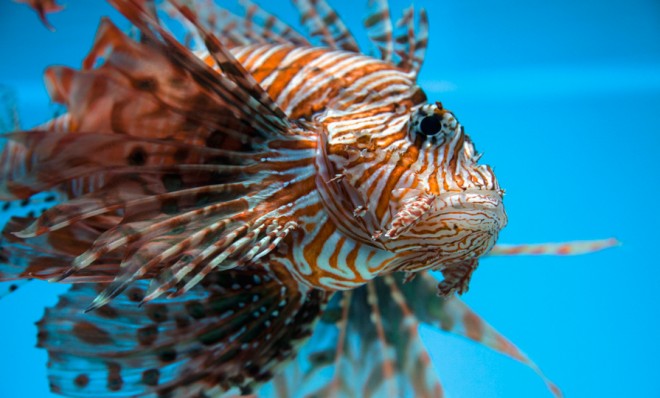The colorful lionfish and 3 other invasive species we should be eating
Yum.

With no natural predators to keep them in check, a sudden surge of invasive species can do irreparable harm to a given area's ecosystem. Conservationists in the United States are now employing a new tactic to curb burgeoning alien populations, calling on chefs and foodies to consider putting them on a plate (or in a crock pot, or on skewers) as a delicacy.
"Conservation can get so serious and dire, we want to put a little fun back in," Laura Huffman, state director of the Texas Nature Conservancy, tells The Atlantic in a new feature.
Here, in no particular order, are four invasive creatures you should consider giving a try:
The Week
Escape your echo chamber. Get the facts behind the news, plus analysis from multiple perspectives.

Sign up for The Week's Free Newsletters
From our morning news briefing to a weekly Good News Newsletter, get the best of The Week delivered directly to your inbox.
From our morning news briefing to a weekly Good News Newsletter, get the best of The Week delivered directly to your inbox.
1. Lionfish
They're striped, colorful, and brimming with venomous toxins, which is at least partly why we're predisposed to think the lionfish more at home in an aquarium than a ceviche. Native to the western Pacific Ocean, the fish have somehow found their way to the Caribbean, the Atlantic, and the Gulf of Mexico, where their populations are blooming thanks mostly to their unusually high perch on the food chain. Aside from sharks, one of the only real threats to lionfish are larger lionfish.
On the plus side, when you safely remove their toxic spikes, the lionfish actually tastes pretty great. According to National Geographic, lionfish have "moist, buttery meat that is often compared to hogfish." One Connecticut sushi chef, in fact, has already given "spear-caught lionfish sashimi" a spot on his menu.
2. Feral hogs
A free daily email with the biggest news stories of the day – and the best features from TheWeek.com
Ask just about any Texan: Wild pigs are a big nuisance and serious problem. Not only are the mammals whip smart (hunters say they send low-ranking group members out to test for traps), but they reproduce at an astonishing rate (a dozen or so piglets a year), and devour everything and anything in their path.
Thankfully, they're still pork, and by the divine will of the gods, bacon. Hunters, in fact, are already using their gamier meat for everything from carnitas to sausages to stews. As one Mother Jones writer — who considers herself "usually a vegetarian" — puts it, the meat from feral boar tastes "tender, dark, smokey, and sweet." Also: "Delicious."

Snakeheads are a top-level predator, and small wonder: In addition to boasting razor-sharp teeth capable of tearing human flesh, they have been spotted on more than one occasion walking on land, where they can live for up to three days thanks to a lung-like adaptation that allows them to breathe out of water.
Add the female snakehead's ability to lay 15,000 eggs in a single year, and you see why they're so hard to control in lakes and ponds all across the United States, including in New York's Central Park, which they somehow managed to squirm to.
Although it likely won't do much to dent their flourishing populations, restaurants in places like Maryland and Washington, D.C., are increasingly putting snakehead meat on the menu. According to Nancy Matsumoto at The Atlantic, Scott Drewno, chef at Wolfgang Puck's top-rated The Source, has a popular recipe for serving the monstrous fish:
[Drewno] cures snakehead with kaffir lime leaves, lemon grass, cane sugar, ginger and garlic for about nine hours, and then smokes it using sencha green tea and serves it with a sauce of garlic chili, soy sauce, rice vinegar, and microgreens. Meaty, smoky, and exotically spiced, the dish is gaining a following. Although it is not on the lunch menu, "people are coming in and asking for it," Drewno reports. [The Atlantic]
4. Asian Tiger Shrimp
Last year, USA Today reported that Asian Tiger shrimp — which can measure up to 13 inches long and weigh nearly a pound — are "spreading through the Gulf of Mexico and Eastern Seaboard and menacing those areas' ecosystem." Females, in fact, lay anywhere from 50,000 to 1 million eggs in a single cycle.
Although they're originally from the western Pacific Ocean, researchers think the crustaceans proliferated from a batch that escaped from a laboratory twenty years ago, or may have hitched a ride in the ballast water of cargo ships. Discovery News calls them "voracious predators" that are known to harbor "numerous diseases that could spread to white and brown shrimp, oysters, and grabs in the Gulf."
So what do these large crustaceans taste like? The prawns are said to have a slightly sweeter flavor than other shrimp, and have been eaten in Southeast Asia for centuries.
-
 Crossword: December 30, 2025
Crossword: December 30, 2025The daily crossword from The Week
-
 What have Trump’s Mar-a-Lago summits achieved?
What have Trump’s Mar-a-Lago summits achieved?Today’s big question Zelenskyy and Netanyahu meet the president in his Palm Beach ‘Winter White House’
-
 The most anticipated movies of 2026
The most anticipated movies of 2026The Week Recommends If the trailers are anything to go by, film buffs are in for a treat